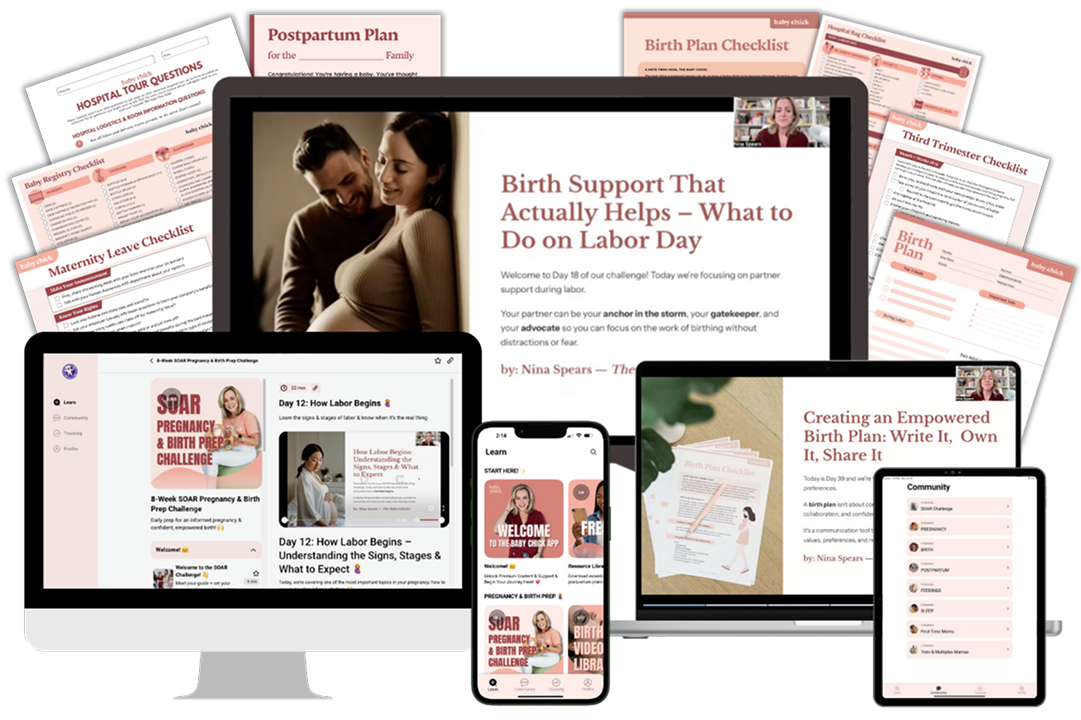Have you ever heard of orgasmic birth? Not many have. Overmedicalization of maternity care, especially in low-risk births, has sterilized the birth experience, taking away access to a full range of comfort, emotional support, and pleasure. We have created a more painful birthing process without a system supporting women and all birthing people to listen to their bodies and feel supported, nurtured, honored, and respected. One that I think creates fear and pain rather than confidence and pleasure. I believe pleasure is our birthright. Let me begin by explaining how I discovered orgasmic birth.
Orgasmic Birth: A Surprising Discovery
My first birth was joyful, challenging, and powerful. The more I attended births as a doula, offering physical and emotional comfort and support during pregnancy, birth, and postpartum, the more I saw orgasmic birth hidden in plain view.
We haven’t had a language for it before. People with positive, pleasurable, joyful, loving, intimate, ecstatic, and orgasmic births often don’t tell anyone. They don’t want to make their friends feel bad about their challenging birth. Many people who experience an orgasm, or what I call a birthgasm, often never even tell their partners or friends out of shame and certainly don’t tell their midwife or doctor. When people started telling me about their birthgasm, they often admitted they had never told anyone before. It was the most expansive orgasm ever. It is a feeling of being one with the universe or divine energy moving through them as pure love—waves of pleasure instead of pain.
Let me be clear: orgasmic birth is not a performance standard. Orgasmic birth is much more than orgasm; I will explain more later. I would never want anyone adding birthgasm to your birth preferences. I feel it is essential to know it happens for those without ever knowing it’s possible and those who prepare for and encourage the opportunity of orgasm during birth. Nature puts the clitoral complex in the same areas involved with childbirth. There must be a reason for nature’s design. Orgasmic birth happens for those who never describe their birth as painful. It can also follow pain and challenge as labor involves riding many waves of sensations and emotions.
The Science of Orgasmic Birth
While creating the documentary Orgasmic Birth: The Best-Kept Secret and interviewing many experts, the science I had longed to find began to appear. One of the experts in the documentary, Dr. Sarah Buckley, wrote a vital report on the Hormonal Physiology of Childbearing: Evidence and Implications for Women, Babies, and Maternity Care.1,2
The report and her interview validated what I saw and heard. The hormones of childbirth are similar to the hormones of sexuality. Birth hormones need the same environment to flow to peak levels as masturbating or making love. Think about planning a sexy evening. What would you like the lights to be like? The sound? The smells? Would you like privacy? What would help you feel safe?
These are the same questions you should be asking about your birth environment. Birth hormones and sex hormones are sensitive and shy. If you had trouble being intimate in a typical hospital room when a stranger walked in and asked you questions, how would the same situation be while you were giving birth? Many of our standard hospital practices disturb rather than support the hormonal flow needed for gentle labor and birth.
The Sensations and Hormones of Birth
Doulas know how sensitive people are in labor to sounds, smells, lights, and the words they hear. Doula Libby Bogdan-Lovis said to Alice Dreger as she helped her prepare for birth, “Birthing a baby requires the same relinquishing of control as does sex—abandoning oneself to the overwhelming sensation and doing so in a protective and supportive environment. If only more women knew how sexy a scientific birth can be.”3
Oxytocin, also called the hormone of love, reaches peak levels with orgasm and even higher peaks after birthing a baby to safely birth the placenta and prepare for breastfeeding and bonding. Oxytocin is often called the cuddle hormone, the hormone of calm and connection.4
What would it be like if you prepared for birth with pleasure? How would birth be different if you saw birth as an extension of your sexuality? Would you want a different environment? What techniques would you use to flow your hormones of love and oxytocin? I prepare all my clients with knowledge of a full range of comfort measures, upright positions, water, tubs, balls, acupressure, affirmations, and words and ways to be loved through labor. I include sensuous touch, nipple stimulation, masturbation, and vibrators. Each person discusses and finds their pleasure chest of comfort measures and oxytocin enhancers they feel safe to explore in labor and birth.
Birth as Part of a Woman’s Sexuality
The silence of discussing birth as a part of a woman’s sexuality is shrouded in taboo and shame. It is time to remove the shame and talk about the obvious: birth is sexual. Birth takes place in the organs of reproduction considered sexual. It involves the cervix, vagina, labia, and vulva and touches nerves of the clitoral complex. The clitoral complex is 8,000 nerves solely designed only for pleasure. The baby passes through the vagina and will contact these nerves.5
In 2018, Margaret Jowitt wrote an article, The Clitoris in Labour, in which she explained the role of the clitoris in labor. “In a nutshell, the baby does the stimulation from the inside with the back of his head when he’s traveled far enough down the birth canal. He will be stimulating the body of the clitoris through the urethra, where the clitoris divides to form the crura. This is the legendary G spot. In the right conditions, birth is orgasmic!”6
Why had no one thought of this? Providers have designed hospital birth for their comfort, so they know everything that is happening all the time. Thus, women are being put on their backs even with years of science saying lying on your back in labor is harmful.7 It can cause the baby to go into distress from lower oxygen levels and make labor longer and often more painful.8 Lithotomy, lying on your back, has become the norm, even against all scientific recommendations. This is why providers don’t see or understand the function of orgasm in childbirth.
It’s simple to understand why women choose upright or leaning forward when allowed to choose their positions for birth. They use gravity to allow more ease, create clitoral pressure, and provide more space for the baby!
Birth as Healing from Sexual Abuse
By removing sex from preparation during birth, we are also doing harm. Many birthing people are survivors of sexual abuse. Birth is a time that offers great healing for those who are prepared, respected, and sensitively cared for. The lack of understanding of how birth can heal or re-traumatize survivors is another reason we must remove the shame of discussing and including the sexuality of childbirth in preparing for birth.
Honoring birth on the continuum of sexuality will require both providers and all who give or support birth to examine their sexuality. To heal, learn, and expand beyond the taboos, shame, and lack of knowledge holding so many back from fully enjoying the pleasure and healthy sexuality in birth and life.
Birthgasm as a Pain Reliever
Research by Lorel Mayberry and Jacqueline Daniel includes birthgasm as a pain reliever.9 In life, we know having a headache is actually a reason to have an orgasm, not to avoid it.10 The same is true in labor. (Once the bag of water releases, nothing should enter the vagina to protect it from infection.) Knowing your many paths to pleasure and orgasm is essential so you have opportunities to increase oxytocin flow with or without orgasm. Imagine if all doctors, midwives, and nurses understood these pain-relieving benefits of pleasure and orgasm. Imagine a world where all people in labor were cared for with the sensitivity that childbirth is a sacred part of sexuality. And a birth room that feels safe, private, and sensual!
Breaking the Silence about Orgasmic Birth
The media is breaking the silence and sharing more about pleasure and intimacy during birth. The TV show Grey’s Anatomy had an episode that talked about the benefits of orgasm and pleasure to help speed slow labor along: “When you add pleasure to pain — pain can become pleasurable!”11
I spoke with Barry Komisaruk, Ph.D., a researcher on the benefits of oxytocin, orgasm, and pain relief for my Orgasmic Birth Virtual Conference. He said, “Some women feel guilty about that, that the baby shouldn’t be producing erotic sensations. But when you understand the physiology of it – the neurophysiology – that the nipple projects to the genital sensory cortex, and a function of it is to facilitate oxytocin release, which is reproductively beneficial. If you can get past the cultural silos of sex and pleasure and reproduction and childcare and all these – making these separate elements – if you can get beyond that and sort of just play it a little bit more casually, then you can understand why the systems are linked as they are. There’s an adaptive significance to it, an adaptive benefit. Hopefully, the cultural constraints that create guilt – maybe if those could be reduced, it could facilitate happiness and relaxation and loss of guilt and hopefully be beneficial.”
There is much to do to get beyond the silos we have created around sexuality, childbirth, and mothering. It is time to change; we know too much to turn back now. We must develop home-like settings for birth: at home, in birth centers, and in hospitals. These should be spaces where safety and privacy are honored, with options for movement, pleasure, singing, dancing, and sexuality to be safely enjoyed. So much more is possible during birth.
















